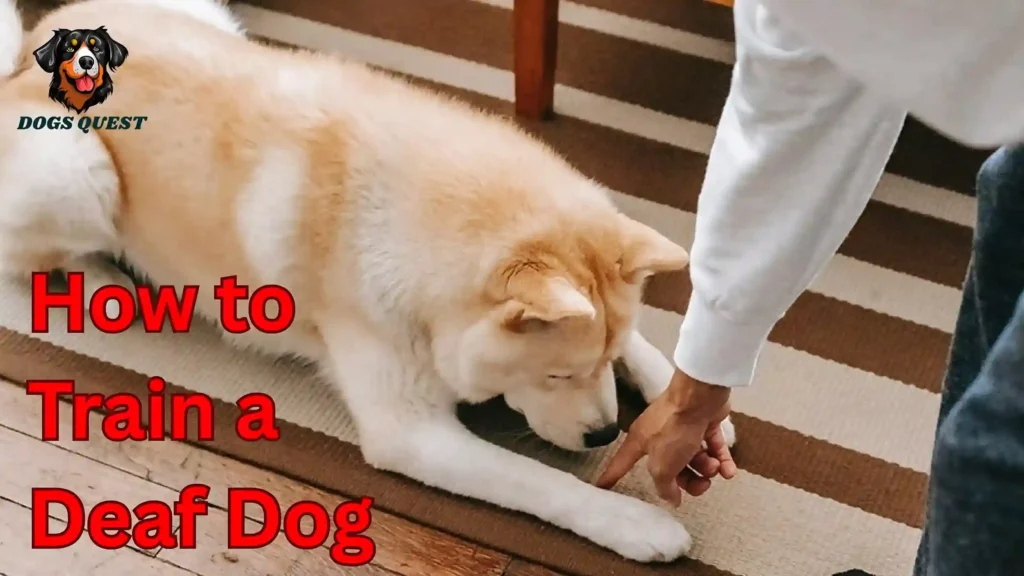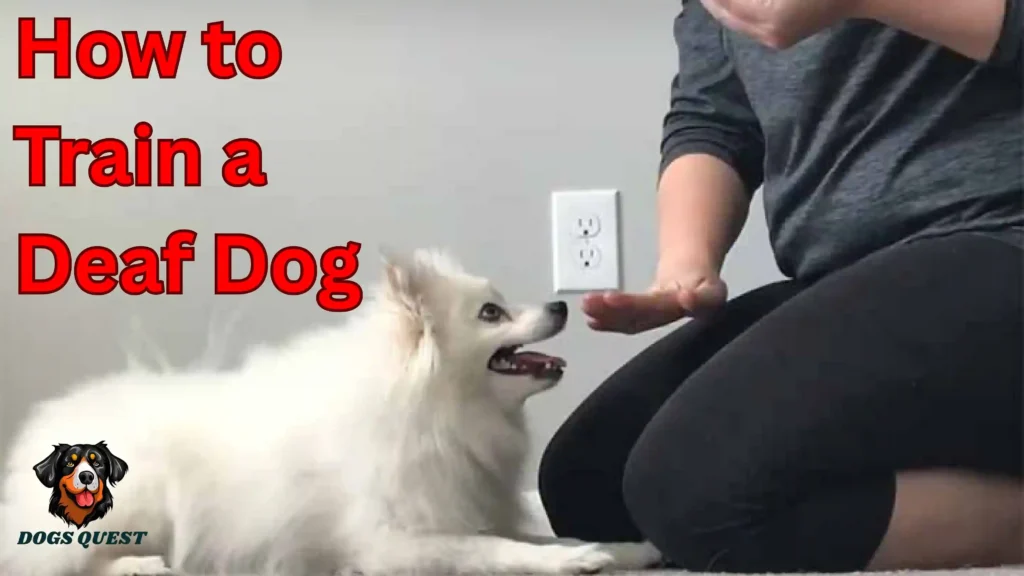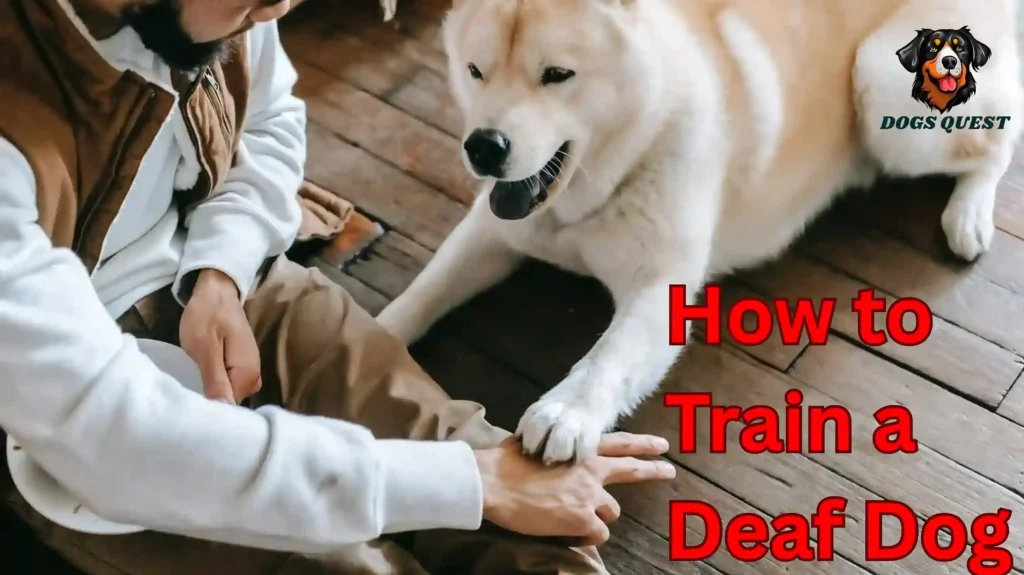Discover how to train a deaf dog with 7 powerful and effective tips. Learn step-by-step methods, hand signals, positive reinforcement, and expert guidance to help your deaf dog live a happy, well-behaved life.
Introduction
Learning how to train a deaf dog may sound overwhelming at first, but with the right methods, it can be one of the most rewarding experiences for any pet parent. Deaf dogs are just as smart, loving, and eager to please as hearing dogs. The main difference is that they rely on visual signals instead of sound.
In this comprehensive guide, you’ll learn how to train a deaf dog step by step using hand signals, body language, positive reinforcement, and structured routines. By the end of this article, you’ll feel confident in your ability to raise a well-mannered deaf dog who trusts and understands you.
Why Learning How to Train a Deaf Dog Matters

A deaf dog can live a perfectly normal and joyful life—but without training, they may struggle with confusion, fear, or unsafe behavior. Knowing how to train a deaf dog ensures they can respond to you in different situations, stay safe outdoors, and bond deeply with you.
Training builds trust, improves confidence, and eliminates common behavior problems. The truth is, once you understand how to train a deaf dog, you’ll realize it’s not harder than training a hearing dog—it’s simply different.
7 Powerful Tips on How to Train a Deaf Dog
1. Use Hand Signals Instead of Voice Commands
One of the most important steps in learning how to train a deaf dog is replacing verbal commands with hand signals. Dogs are excellent at reading body language, and they can quickly learn to associate specific gestures with actions.
Best Practices for Hand Signals
- Use clear, consistent gestures for each command.
- Keep movements distinct to avoid confusion.
- Pair signals with rewards every time.
Popular signals include:
- Sit → Raise your hand with palm up.
- Stay → Extend your palm forward like a stop sign.
- Come → Sweep your hand toward your chest.
The key is consistency—once your dog learns a signal, never change it.
2. Rely on Positive Reinforcement
When mastering how to train a deaf dog, positive reinforcement is your strongest tool. Deaf dogs may not hear praise, but they absolutely understand rewards.
Reward Options for Deaf Dogs
- Tasty treats
- Gentle pats and belly rubs
- Toys and playtime
- A “thumbs-up” as a visual cue for “good job”
Never punish or yell at your deaf dog. Instead, focus on rewarding correct behaviors consistently.
3. Establish Eye Contact as a Foundation

A key step in learning how to train a deaf dog is teaching them to look at you often. Since they can’t hear your voice, eye contact becomes the bridge for communication.
How to Build Eye Contact
- Hold a treat by your face until your dog looks at you.
- Reward them instantly when their eyes meet yours.
- Repeat until eye contact becomes natural.
Once this habit is formed, you’ll notice your dog checks in with you regularly for guidance.
4. Train with Light and Vibration Cues
When practicing how to train a deaf dog, you can also use alternative cues like lights or vibrations.
- Light signals: A small flashlight or switching a room light on/off can get your dog’s attention indoors.
- Vibration cues: Lightly tapping the floor or using a vibration collar (not a shock collar) can gently alert them without causing fear.
These tools are especially useful when your dog is not looking directly at you.
5. Create a Consistent Routine
A structured daily routine makes it easier for your deaf dog to understand expectations. When focusing on how to train a deaf dog, routines help them predict when it’s time for meals, walks, play, or rest.
- Feed and walk your dog at the same times daily.
- Use hand signals for bedtime, playtime, or feeding.
- Keep training sessions short (5–10 minutes) but frequent.
Consistency helps your dog feel safe and secure.
6. Ensure Safety Through Training
One of the most critical reasons for learning how to train a deaf dog is safety. Because they can’t hear dangers like cars, horns, or other dogs, training is vital to protect them.
Safety Training Tips
- Teach a strong recall (come command).
- Always use a leash outdoors unless in a secure fenced yard.
- Consider a vibrating collar for emergencies.
By prioritizing safety, you give your deaf dog the freedom to explore confidently without unnecessary risks.
7. Be Patient and Celebrate Progress

Patience is the heart of how to train a deaf dog. Since they rely heavily on visual and physical cues, it may take extra repetition for them to master commands.
Celebrate small victories. Even if your dog learns “sit” or “stay” after several days, that’s a major milestone. With love, patience, and consistency, progress will come naturally.
Additional Strategies on How to Train a Deaf Dog
Socialization Is Still Essential
Even if your dog is deaf, they still need exposure to people, pets, and new environments. Early socialization helps them adapt without fear.
Combine Touch Cues with Training
A gentle shoulder tap can be another signal for attention. Always pair touch with a reward so your dog sees it positively.
Stay Calm and Confident
Dogs sense your energy. When working on how to train a deaf dog, your calm confidence will reassure them.
Common Mistakes to Avoid When Training a Deaf Dog

- Using inconsistent hand signals – This confuses your dog.
- Neglecting rewards – Deaf dogs need clear reinforcement.
- Over-relying on vibration collars – Use them only as attention cues, not as the main training method.
- Expecting instant results – Training takes time for all dogs, especially deaf ones.
Avoiding these mistakes ensures faster, more reliable results.
Conclusion
Understanding how to train a deaf dog is about patience, consistency, and creativity. By using hand signals, positive reinforcement, visual cues, and safe practices, you can help your deaf dog thrive.
Remember, deafness doesn’t define your dog—it’s just a different way of experiencing the world. With your guidance, love, and training, your dog will lead a happy, safe, and fulfilling life.
FAQs About How to Train a Deaf Dog
Q1. Can you really train a deaf dog?
Yes! Deaf dogs can learn everything a hearing dog can. You just use hand signals and visual cues instead of voice commands.
Q2. How long does it take to train a deaf dog?
It depends on the dog’s age, personality, and consistency of training. With daily practice, many dogs learn basic commands in a few weeks.
Q3. Are vibration collars safe for deaf dogs?
Yes, as long as they are vibration-only and not shock collars. They’re meant for attention, not punishment.
Q4. Can deaf dogs compete in dog sports?
Absolutely! Deaf dogs excel in agility, obedience, and even therapy work once properly trained.
Q5. Is training a deaf dog harder than training a hearing dog?
Not harder—just different. Once you know how to train a deaf dog, the process becomes just as enjoyable as with any other dog.

